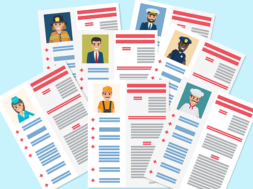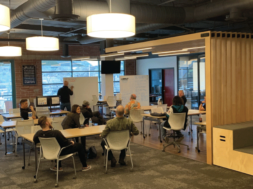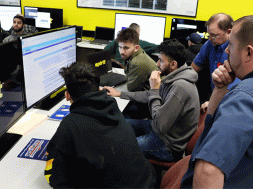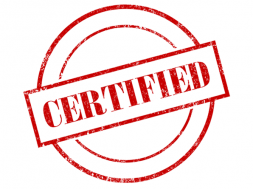
Healthcare Apprenticeship Programs: A Guide for Educators
By Susan Dalebout, Director of Business Development, National Healthcareer Association
On June 15, 2017, President Trump signed an executive order that nearly doubled annual funding for apprenticeship programs from $90 to $200 million. The initiative strives to accelerate apprenticeship growth by targeting key industry sectors in the United States, and one of the most ambitious goals is to develop one working apprentice for every four college students – aggressively increasing the nation’s apprentices from 500,000 to 5 million.1
In response to this order, apprenticeships, which have traditionally been used in industries such as construction, are now expanding into other sectors where demand is high.
Healthcare, for example, is a key industry due to the fact that the gap between openings and hires has been widening at a rapid pace since 2014.2
A challenge that apprenticeships are helping overcome is that employers need qualified candidates to fill allied health roles, such as the Medical Assistant (MA), but educators aren’t producing enough graduates to fill the growing demand. Registered Apprenticeship programs give employers the ability to fill gaps immediately, while providing opportunities for students to learn valuable skills through on-the-job training – earning wages as they learn and work toward certification.
It’s a newer model for healthcare, and early models are seeing great success. Apprentices are gaining access to a valuable education and career opportunity. Employers are filling skills gaps with qualified employees while increasing their retention and improving quality of care. And educators are increasing enrollment and expanding their reach through innovative programming.
How do registered apprenticeships work?
Registered apprenticeships are often a collaborative effort between educational institutions (accredited training, K-12 career and technical education, military, non-credit post-secondary training), trade associations (unions, industry associations, sector partnerships), workforce development (workforce investment boards, workforce training centers), employers and federal agencies. Some core components of this “earn while you learn” model include:
1. Employer involvement. At the foundation of every apprenticeship program, employers help shape and build the program, remaining involved every step of the way. They know best what skills are needed in the workforce today and can help develop the program and curriculum requirements.
2. Structured on-the-job learning. Apprenticeships include a work-based learning component with support from a mentor who is fully competent in the occupation. The training is based on national industry standards, customized to the needs of the particular employer.
3. Related technical institution (RTI). RTI covers the technical and academic knowledge that applies to the occupation. Depending on the type of apprenticeship, RTI can be delivered by the employer, union-based trainers or more commonly by an education partner including community colleges and universities.
4. Rewards for skill gains. Apprentices immediately begin receiving wages during their training, and their earnings increase as they improve in skills and competencies.
5. Recognized credential. After finishing the program, apprentices gain a certificate of completion. Apprentices are then eligible to take a certification exam to earn nationally recognized, portable credential, such as one of the eight nationally-recognized allied health certifications from National Healthcareer Association (NHA). This signifies to employers that apprentices are fully qualified for the job.
Applying this apprenticeship model to healthcare is relatively new territory, but those who are taking the leap are experiencing positive outcomes. Jake McClelland, Executive Director for Southwestern Oregon Workforce Investment Board (SOWIB), a business-led 501(c)(3) partnership, saw apprenticeship as an opportunity to not only certify existing medical assistants (MAs), but to also have a constant pipeline of candidates to fill open positions.
In the SOWIB apprenticeship program – which started with five employee sponsors to start – participants are paid by the employers for their 2,000 hours of hands-on training. They must also complete 156 hours of mostly online studies. Once each month, all the apprentices come together for an in-person session in which skills acquired from the field are reinforced.
One of the key benefits of the SOWIB program is that employers can hire apprentices immediately, they don’t have to wait for them to complete their educational program.
An issue before was that, for example, an employer could need to hire two MAs, but six completed their certification at a local community college. Later on, that same employer might need to hire four more, but those qualified candidates would have already moved on and the employer would then have to wait for another program to end and hope that enough candidates earned their certification. With apprenticeships, employers hire the number of people they need, when they need them. “Our apprenticeship mirrors what the employers’ normal hiring patterns are,” McClelland says. “Supply and demand are always in alignment.”
While employers are not required to hire apprentices at the end of their program, all of the Oregon participants have been hired by their training agent, and the U.S. Department of Labor reports 94 percent of apprentices continue employment at the conclusion of an apprenticeship program.
The role of educators in apprenticeships
While on-the-job training is a key differentiator for apprenticeship programs, educators still play a vital role in the “classroom” portion. Educational institutions and instructors provide technical knowledge to support work-based learning and will typically be decided using the following factors:
- Healthcare occupational education and certification requirements
- Cost, length and timing of delivering the program
- Whether post-secondary credit is available or if the instruction can be translated into credit
- The ability to customize coursework to meet healthcare industry needs
The “classroom” portion of training may be completed in-person, online or as a combination of the two. Many apprenticeship programs use educational providers such as community colleges to fulfill their classroom requirements. In the SOWIB program, all coursework is completed online with an instructor to offer the most flexibility to both the employers and the apprentices. Students may begin at any time without having to wait for a semester to begin, and the instructor delivers coursework to them at their pace.
How do apprenticeship programs benefit educational institutions?
Even though apprentices likely spend little to no time in a physical classroom, educators have a lot to gain from apprenticeship.
1. Improved retention. In high demand occupations, students are often hired part way through their programs and they may not complete their education. With the apprenticeship model, they can start working with their employer and finish their certification programs, which helps improve retention.
2. Increased enrollment. Flexible training models provide opportunities to a wider student base, particularly adult learners. Plus, with the potential for government funding, students may receive their training at little to no cost – which also helps provide greater access by removing many of the financial barriers that prevent individuals from starting down these pathways.
3. Creative solutions for distance education. Students are empowered to train for their careers while remaining in their home communities. Employer sponsors are able to provide the on-the-job experience that complements educational programs, and students who are unable to relocate can now pursue education and certification.
4. Recognition. By providing the instruction for apprenticeship programs, educational programs are automatically promoted to potential students and employers by DLI representatives. Programs receive recognition on the state level for their dedication to meeting workforce needs.
5. Potential for students to further education after apprenticeship. Apprenticeships encourage students to continue with their education through additional programs. For example, roles such as the CNA and MA are seen as entryways to the clinical portion of healthcare, and many continue their education to become a Licensed Practical Nurse (LPN) or Registered Nurse (RN) and beyond.3
New apprenticeship programs can help improve educational providers’ ability to meet their region’s workforce education needs while also providing more opportunities to adult learners, like Caitlin, one of the first MA’s to complete the SOWIB program.
“The apprenticeship program has given me so much more confidence in my current career,” she says. “Not only do I have the skills, but now I also have the education to be able to assist patients and my employer the best way possible. It’s incredibly empowering to have this opportunity. I look forward to seeing how it continues to change my career and life for the better.”
How should you get started?
If you’re interested in getting a Registered Apprenticeship program started in your region, McClelland recommends reaching out to your state apprenticeship agency. “They were a big help for us when we got started and assigned someone to come down and help with the bureaucracy part of it,” he says.
It may also be beneficial to consult with professionals who have been part of a successful Registered Apprenticeship model.
NHA, the nations’ largest health career certification provider, provided support to SOWIB by helping make connections with other apprenticeship programs that the organization has worked with in providing the certification component. Now, McClelland himself is consulting other organizations as they begin to embark on their healthcare apprenticeship programs. By sharing one another’s learnings, Registered Apprenticeships in healthcare will continue to evolve and improve the future of healthcare education.
The Registered Apprenticeship model is a paradigm shift in healthcare. Instead of graduating allied health students and sending them on to hopefully find employment, educators, government agencies and employers are working together to help empower all parties, close the skills gap and improve patient care. While it can seem intimidating to get started, the outcomes have proven to be successful and there is support available to help you get started on the right track.
*For more information about Registered Apprenticeships in healthcare, see the “Additional Resources” section below.
References
- National Skills Coalition, “Getting to Five Million Apprentices: Federal Options for Expanding Work-Based Learning.” April 2017. https://www.nationalskillscoalition.org/resources/publications/file/Getting-to-5-Million-Apprentices-web.pdf.
- AMN Healthcare, “Future for Healthcare Jobs: Seven Charts Show Intensifying Demand for Services and Workforce.” https://www.amnhealthcare.com/latest-healthcare-news/future-for-healthcare-jobs/#jobs
- U.S. Dept. of Labor, “Using Registered Apprenticeship to Build and Fill Healthcare Career Paths.” https://www.doleta.gov/oa/pdf/apprenticeship_build_healthcare_paths.pdf
Additional Resources
NHA Case Study: “Empowered by Apprenticeship: Registered Apprenticeship helps employers fulfill Meaningful Use while helping job seekers access new career opportunities”
NHA Case Study: “Apprenticeship Leads to High Pass Rates & Improved Care”
U.S. Department of Labor Apprenticeship Website
SUSAN DALEBOUT has spent her career helping students, educators and employers understand standardized exam preparation and exams leading to candidate success on standardized exams and opening the door to new or additional education and career opportunities. The past six years have been dedicated to NHA and leading a team focused on providing a quality certification preparation and exam experience for allied health students, programs and employers in the U.S. Working together with peers and leadership, Susan has been part of NHA’s focus on successfully attaining industry leading customer satisfaction scores. Prior to NHA, Susan spent time at Kaplan Test Prep and Admissions developing teams with work tied directly back to individual students and their fulfillment of dreams to attend great universities, graduate programs or achieve professional licensure or certification. Providing a pathway to increased opportunity through education and job training is a topic Susan is passionate about!
Contact Information: Susan Dalebout // Director of Business Development // National Healthcareer Association // 913-661-6108 // susan.dalebout@nhanow.com // nhanow.com // https://www.linkedin.com/company/national-healthcareer-association/ // https://www.facebook.com/nationalhealthcareerassociation/ // https://twitter.com/nha // https://www.instagram.com/iamnhacertified/











